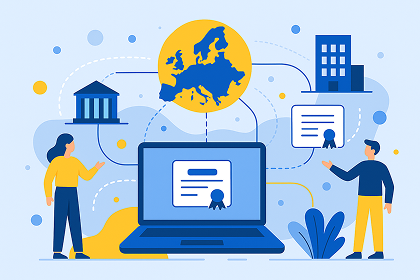No user accounts required for your recipients -
Existing certificates and badges always stay valid


A deep dive into the European Learning Model: Definition, purpose, key actors, and current development stage



The European Learning Model (ELM) is a key initiative by the European Commission that defines how learning, skills, and qualifications are represented in a consistent and interoperable way across Europe. It addresses a growing challenge in education: the need to exchange and verify learning data between different systems and countries without losing meaning or accuracy.
For educational institutions, universities, and training providers, this model provides a foundation for transparency and trust in the digital credentialing process. It supports a shared understanding of qualifications and learning outcomes, no matter where they were achieved.
Main reasons why the ELM matters for education providers:
The European Learning Model adds a structured and standardized data model that ensures compatibility across all European systems. It helps education providers align their digital certificates with European data standards, ensuring that qualifications remain verifiable and transparent across different platforms and countries.
The ELM is part of a broader movement toward a trusted digital learning ecosystem. It is not only a technical innovation but a strategic effort to make European education more transparent, verifiable, and internationally comparable.
The European Learning Model is a data model developed by the European Commission. The ELM ensures that learning-related data can be read, understood, and verified across borders and systems.
Key characteristics of the European Learning Model:
The ELM is closely linked to the Europass framework, which promotes transparency and comparability of skills and qualifications. While Europass focuses on helping individuals present their skills and achievements, the ELM provides the technical foundation that allows software systems to exchange this data consistently.
The model is built on modern web technologies and follows open data principles. It is based on the W3C Verifiable Credentials Standard, which defines how digital certificates can be issued, held, and verified securely. This standard ensures that credentials are tamper-proof and machine-readable.
To explore this technical background in more detail, you can refer to the article W3C VC Standard: The Future of Verifiable Digital Credentials.
Benefits of using the ELM for education providers:
The European Learning Model marks a fundamental step toward a unified, verifiable, and interoperable credentialing landscape across Europe.
The European Learning Model defines the structure and meaning of learning data, but it is only one part of the full European credentialing framework. To create digital certificates that are both interoperable and technically verifiable, the ELM works together with another critical component: the W3C Verifiable Credentials standard.
How these two elements interact:
When combined, they form the foundation of EDC, the European Digital Credentials for Learning framework.
This combination is what enables fully verifiable, tamper-proof, and cross-border compatible digital credentials. It is also the direction in which European education policy is moving, making this framework increasingly relevant for universities, training providers, and certification platforms.
The European Learning Model aims to serve as the foundation for a modern education ecosystem where qualifications and skills can be recognized regardless of where they are earned.
Main objectives of the ELM:
For education providers, the ELM offers a clear framework to future-proof their credentialing processes. By adopting its standards, institutions can ensure that their certificates remain verifiable and understandable throughout Europe. It helps create trust, promotes recognition, and reduces administrative barriers in cross-border education.
The European Learning Model is currently coordinated and maintained by the European Commission, specifically through the Directorate-General for Employment, Social Affairs and Inclusion (DG EMPL). This department oversees initiatives related to education, skills, and workforce development.
Key entities involved:
These stakeholders work together to ensure that the ELM remains up to date, transparent, and usable by all European education systems. Their collaboration also supports the alignment between policy goals and technical standards, ensuring that the ELM evolves in step with the digital transformation of education.
The European Learning Model has been under continuous development since its first release and is currently in version 3 (as of November 2025), which was launched by the European Commission in 2023. This version expanded the model’s scope to cover more types of learning data, including micro-credentials, accreditation, and digital credentials aligned with the Europass framework.
Current developments:
The European Commission has not announced a fixed completion date but is progressing toward full integration within Europass. The goal is to ensure that by the late 2020s, all European countries and education institutions use or are compatible with the ELM for managing and verifying learning data.
For education providers, the European Learning Model is both a strategic opportunity and a practical framework. It defines how digital credentials and qualifications can be structured, verified, and exchanged in a trusted way. Institutions that align early with this model can ensure their certificates are future-proof and recognized across borders.
Key advantages for institutions:
The European Learning Model plays an important role in connecting institutions, learners, and employers across Europe. It helps organizations understand how digital credentials can fit into the evolving landscape of European data practices and emerging interoperability standards, without requiring immediate adoption or technical implementation.
* You can find the organisation ID in the URL when you access your LinkedIn Company page as an admin.


Marketing
Nov 21, 2025
7 min
Use Virtualbadge.io to design and send digital certificates that create trust - in less than 10 minutes.